
“Walking is man’s best medicine.”
– Hippocrates
Benefits of Walking (With Medical Evidence)
1. Improves Heart Health
Walking is an aerobic exercise that strengthens the heart and boosts blood circulation.
A large-scale study by Manson et al., published in JAMA (2002), found that brisk walking
for 3+ hours weekly reduced heart disease risk by up to 40% in postmenopausal women.
[Source]Manson JE et al., JAMA. 2002;288(18):2300–2306
2. Boosts Metabolism
Walking activates large muscle groups and burns calories, raising your basal metabolic rate (BMR).
According to a study in the American Journal of Clinical Nutrition, even low-intensity
walking increases energy expenditure significantly throughout the day.
[Source]Levine JA et al., Am J Clin Nutr. 2005;82(5):996–1002
3. Reduces Stress and Anxiety
Walking lowers cortisol (stress hormone) and boosts endorphins. A 2018 study showed that even
10 minutes of walking can reduce anxiety and improve mood.
[Source]Edwards MK & Loprinzi PD, Health Promot Perspect. 2018;8(1):31–36
4. Supports Joint Health
Walking strengthens muscles around the joints and nourishes cartilage. In a study published in
Annals of Internal Medicine, walking 6,000+ steps/day helped prevent arthritis progression.
[Source]White DK et al., Ann Intern Med. 2014;161(9):612–621
5. Low-Impact and Inclusive
Walking is suitable for all ages and fitness levels. The U.S. government recommends it as a primary
form of physical activity for older adults due to its safety and sustainability.
[Source]Physical Activity Guidelines for Americans, 2nd Edition, 2018
Summary Table:
| Benefit | Supported By |
|---|---|
| Heart Health | Manson et al., JAMA, 2002 |
| Boosts Metabolism | Levine et al., AJCN, 2005 |
| Reduces Stress | Edwards & Loprinzi, 2018 |
| Joint Health | White et al., 2014 |
| Inclusive & Safe | HHS Guidelines, 2018 |
How Walking Helps with Weight Loss
Regular walking burns calories, especially when combined with a calorie-controlled diet. It helps create a consistent calorie deficit necessary for fat loss.
A study published in the journal Obesity (2007) showed that walking 30–60 minutes a day can significantly reduce body fat and BMI in overweight individuals.
[Source]Jakicic JM et al., Obesity (Silver Spring). 2007;15(3):647–656
Calories Burned by Walking
The calories you burn depend on speed, distance, and body weight. Here's a rough estimate:
| Weight | Walking Speed | Calories / 30 mins |
|---|---|---|
| 60 kg | 5 km/h | 120 |
| 75 kg | 5 km/h | 150 |
| 90 kg | 5 km/h | 180 |
Tips to Boost Results
- Walk briskly (100 steps per minute or more)
- Use good posture and comfortable shoes
- Add inclines or stairs
- Walk after meals to aid digestion
- Stay consistent and track steps
7-Day Beginner Walking Plan
Day 1: 20 minutes easy walk
Day 2: 25 minutes brisk walk
Day 3: 30 minutes walk + 5 mins incline
Day 4: Light stretching or rest
Day 5: 35 minutes brisk walk
Day 6: 30 mins brisk + 10 mins stairs
Day 7: 40 minutes easy walk

Final Tips & Encouragement
Start small and build gradually. Track your steps. Stay hydrated. Combine walking with healthy eating. Every step counts toward your weight loss goal!